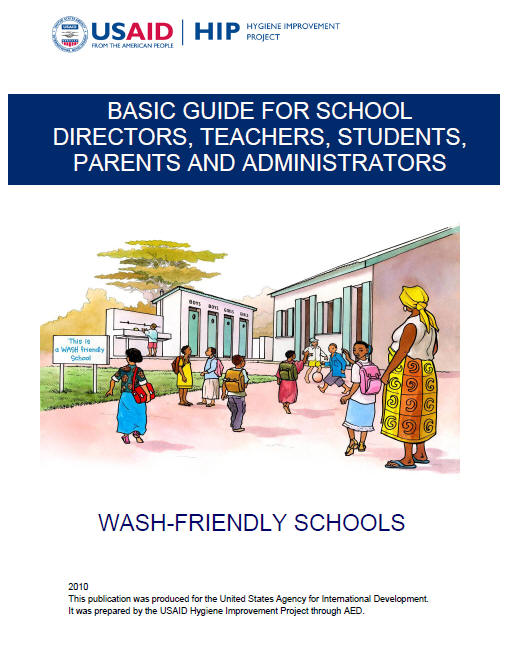WASH-Friendly School Basis Guide for School Directors, Teachers, Students, Parents and Administrators
 |
rapport Aug 2010 ; 72 pages
Ed. HIP - Antananarivo USAID - Washington
Téléchargeable sous format: PdF
Téléchargeable chez l'éditeur
Abstract:
This resource guide promotes the WASH (water, sanitation, and hygiene) in Schools movement to create and maintain "WASH-Friendly Schools" that have safe and healthy environments, including adequate facilities for hygiene and sanitation that allow children to be healthier and more attentive. The contents are adapted from United States Agency for International Development (USAID)’s Hygiene Improvement Project (HIP) country-specific experiences in Madagascar and Ethiopia.
The booklet introduces the WASH-Friendly School concept through illustrations and steps for programme-building. "While the guide can serve to help any single school to work toward becoming WASH friendly, it was written under the assumption that a focus on WASH-Friendly Schools is part of a broader WASH initiative....A WASH-Friendly Schools initiative may be part of a national, regional, or local government program organized by the health and/or education sector; it may be part of a special initiative for school improvement, or of national school or curriculum reform; it can be a subset of a Community-Led Total Sanitation effort; or possibly an outcome of awareness raising through energetic participation in Global Handwashing Day." Contents:
# What is a WASH-Friendly School?
# Enabling Environment for WASH-Friendly Schools
# Why Is It Important to Have WASH-Friendly Schools?
# What Are the Critical Elements of a WASH-Friendly School?
# What is the Process for Becoming WASH-Friendly?
# How Will Schools Be Evaluated to Receive “WASH-Friendly” Status and Rewards?
# Staying WASH-Friendly: What Happens after the Celebrations?
# Annexes: Guidelines and Tools for Each Step
# Annex A: Outline for Training Teachers, Parents, and Student Leaders as WASH Champions
# Annex B: Whole System in the Room District Meeting
# Annex C: Five Ignition Tools for Raising Awareness and Commitment to Action to Achieve Wash- Friendly Schools
* TOOL No. 1-Organizing the Walk of Shame
* TOOL No. 2-Mapping (School Map)
* TOOL No. 3-Feces Calculation
* TOOL No. 4-Feces Flow Diagram
* TOOL No. 5-Glass of Water Exercise
# Annex D: Technical Section
# Annex E: WASH Survey Form
# Annex F: Sample WASH-Friendly Pledge
# Annex G: WASH Action Planning Table
# Annex H: Examples of Classroom WASH Lessons
# Annex I: Establishment of a School WASH Club
# Annex J: Establishment of School WASH Committees or Mobilizing Parent Associations for WASH
# Annex K: Evaluation Grid for Assessing “WASH-Friendly” Status and School “Report Card”
# Annex L: Example of WASH Themed Classroom Poster
# Online Resources: WASH in Schools Websites, Publications, and Videos
Public-Cible:
Mots clefs: |
assainissement (CI) (DT) (OP) (ope) , école (CI) (DT) (OP) (ope) , hygiène (CI) (DT) (OP) (ope) |
Pays concerné: |
Editeurs/Diffuseurs: |
|
HIP
-
Hygiene Improvement Project - Antananarivo - Madagascar |
USAID
-
US Agency for International Development - Washington - Etats Unis |
En cas de lien brisé, nous le mentionner à communication@pseau.org